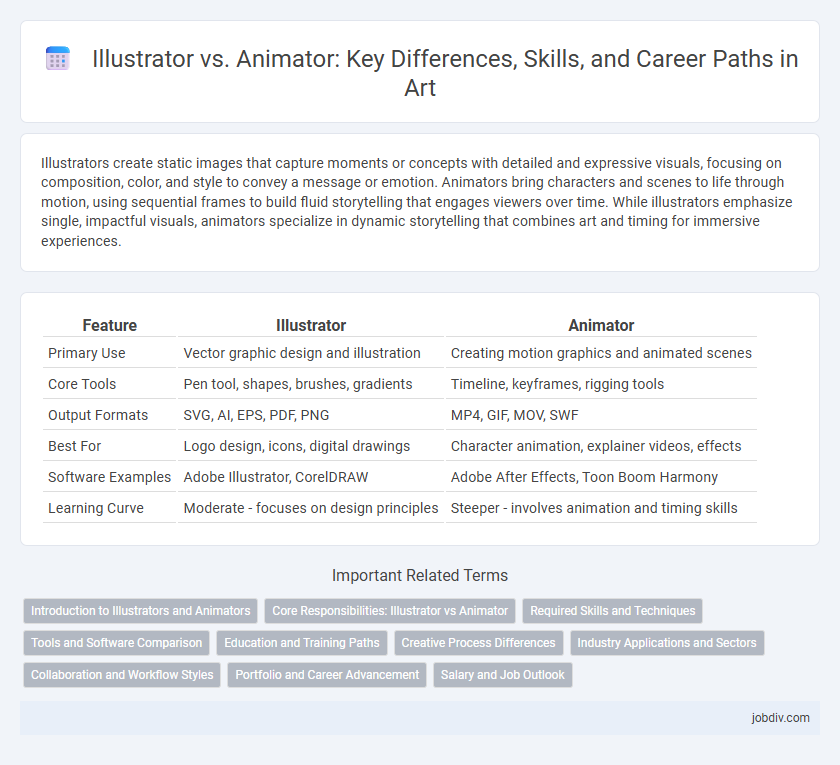Illustrators create static images that capture moments or concepts with detailed and expressive visuals, focusing on composition, color, and style to convey a message or emotion. Animators bring characters and scenes to life through motion, using sequential frames to build fluid storytelling that engages viewers over time. While illustrators emphasize single, impactful visuals, animators specialize in dynamic storytelling that combines art and timing for immersive experiences.
Table of Comparison
| Feature | Illustrator | Animator |
|---|---|---|
| Primary Use | Vector graphic design and illustration | Creating motion graphics and animated scenes |
| Core Tools | Pen tool, shapes, brushes, gradients | Timeline, keyframes, rigging tools |
| Output Formats | SVG, AI, EPS, PDF, PNG | MP4, GIF, MOV, SWF |
| Best For | Logo design, icons, digital drawings | Character animation, explainer videos, effects |
| Software Examples | Adobe Illustrator, CorelDRAW | Adobe After Effects, Toon Boom Harmony |
| Learning Curve | Moderate - focuses on design principles | Steeper - involves animation and timing skills |
Introduction to Illustrators and Animators
Illustrators create static images that communicate ideas, emotions, or stories through visual art, often used in books, advertisements, and multimedia. Animators bring images to life by designing sequences of moving visuals that tell dynamic stories in films, video games, and digital media. Both professions require artistic skills and creative vision, but illustrators focus on singular compositions while animators emphasize motion and timing.
Core Responsibilities: Illustrator vs Animator
Illustrators specialize in creating static images that convey ideas, emotions, or narratives using tools such as digital tablets or traditional media. Animators focus on bringing characters and scenes to life by producing sequences of moving images through software like Adobe After Effects or Toon Boom Harmony. Core responsibilities for illustrators include concept development and visual storytelling, while animators emphasize frame-by-frame movement, timing, and character rigging.
Required Skills and Techniques
Illustrators excel in mastering composition, color theory, and digital drawing tools like Adobe Illustrator and Procreate to create static visuals with impactful storytelling. Animators require proficiency in motion principles, timing, and software such as Adobe After Effects, Toon Boom Harmony, or Blender to bring characters and scenes to life through fluid movement. Both roles demand a strong understanding of visual storytelling but differ in their technical focus on still imagery versus dynamic animation.
Tools and Software Comparison
Illustrators primarily use software like Adobe Illustrator, CorelDRAW, and Procreate, which excel in vector graphics, precise line work, and static image creation. Animators rely on tools such as Adobe After Effects, Toon Boom Harmony, and Blender for crafting motion graphics, frame-by-frame animation, and 3D modeling. Workflow efficiency depends on software capabilities, with illustrators focusing on design accuracy while animators prioritize timeline control and dynamic rendering features.
Education and Training Paths
Illustrators typically pursue a Bachelor of Fine Arts (BFA) in Illustration or Graphic Design, emphasizing courses in drawing, digital tools, and visual storytelling, while animators often study Animation, Computer Graphics, or Multimedia Arts with a focus on 2D/3D animation, character design, and motion graphics. Both fields benefit from proficiency in software such as Adobe Creative Suite for illustrators and Autodesk Maya or Toon Boom for animators. Specialized training programs, online courses, and internships enhance practical skills and industry readiness in both professions.
Creative Process Differences
Illustrators primarily focus on creating static, detailed images that convey a message or story through composition, color theory, and line work. Animators develop sequential frames to produce motion, emphasizing timing, fluidity, and character dynamics to bring illustrations to life. The creative process for illustrators centers on refining single impactful visuals, while animators engage in iterative storytelling through frame-by-frame movement and transitions.
Industry Applications and Sectors
Illustrators predominantly contribute to publishing, advertising, and product packaging sectors by creating static visuals and concept art that enhance brand identity and storytelling. Animators are vital in entertainment, gaming, and multimedia industries, producing dynamic content such as motion graphics, character animations, and visual effects to engage audiences. Both roles overlap in film production and digital marketing, where integrated skills drive immersive experiences and cross-platform campaigns.
Collaboration and Workflow Styles
Illustrators and animators often collaborate by integrating static designs with dynamic motion, enhancing storytelling through seamless visual transitions. Workflow styles differ as illustrators typically follow a linear process of concept to finalized artwork, while animators adopt iterative approaches involving keyframing and timing adjustments. Efficient collaboration relies on shared digital tools like Adobe Creative Cloud, enabling real-time feedback and streamlined asset exchange.
Portfolio and Career Advancement
Illustrators build diverse portfolios showcasing static visual storytelling, character design, and conceptual art, which are essential for securing freelance projects and gallery exhibitions. Animators demonstrate their skills through dynamic reels featuring motion graphics, character animation, and storytelling sequences, crucial for roles in film, gaming, and advertising industries. A well-curated portfolio tailored to industry demands significantly accelerates career advancement in either field by highlighting technical proficiency and creative versatility.
Salary and Job Outlook
Illustrators typically earn a median annual salary of around $55,000, while animators average closer to $75,000, reflecting the higher demand in digital media and entertainment industries. The job outlook for animators is projected to grow 19% over the next decade due to expanding opportunities in video games, movies, and virtual reality, whereas illustrators face a slower growth rate of about 4%, mainly in publishing and advertising sectors. Skills in digital tools like Adobe Creative Suite and 3D modeling software heavily influence both salary potential and employment prospects in these creative fields.
Illustrator vs Animator Infographic

 jobdiv.com
jobdiv.com